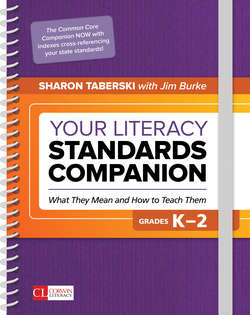Читать книгу Your Literacy Standards Companion, Grades K-2 - Jim Burke - Страница 10
На сайте Литреса книга снята с продажи.
A Brief Orientation to Your Literacy Standards Companion, Grades K–2
ОглавлениеWhen I was asked to write this book, I was relieved to see I could follow Jim Burke’s smart format and design. He envisioned this series as something highly useful to teachers and organized each volume around the following features:
A one-page overview of all the anchor standards. Designed for quick reference or self- assessment, this one-page document offers a one-stop place to see all the English Language Arts Common Core Standards. In addition to using this to quickly check the Common Core anchor standards, grade-level teachers or the whole faculty might use the overview to evaluate which standards they know and are addressing effectively and which ones they need to learn and teach.
Side-by-side anchor standards translation. The Common Core State Standards College and Career Readiness anchor standards for each category—reading, foundational skills, writing, speaking and listening, and language—appear in a two-page spread with the original Common Core anchor standards on the left and, on the right, their matching translations in language that is more accessible to those on the run or new to literacy instruction.
A new user-friendly format for each standard. Instead of the two reading standard domains—literature and informational text—spread throughout as they are in the Common Core State Standards document, here you will find the first reading standard for grades K–2 and the two different domains all on one page. This allows you to use Your Literacy Standards Companion to see at a glance what Reading Standard 1 looks like in grades K–2 across literature and informational texts. The design makes it easy to see how the standard plays out across grade levels, so you can plan with other teachers just how to increase complexity as students move from grade to grade.
Parallel translation/what students do. Each standard opens to a two-page spread that has the original Common Core standards on the left and a parallel translation of each standard mirrored on the right-hand page in more accessible language (referred to as the “Gist”) so you can concentrate on how to teach in ways that meet the standards instead of how to understand them. These Gist pages align themselves with the original Common Core, so you can move between the two without turning a page as you think about what the standards mean and how to teach to meet them. Also, beneath each translation of a standard appears a list of what students consider. These are brief practical questions that will help students “crack open” the thinking and comprehension skills being asked of them. Ultimately, students pose these questions for themselves—both unconsciously and deliberately—as they engage in the endeavor. But because metacognition is something students grow into, you can use these questions as comprehension questions to pose after you model how to approach them. The goal is to provide ample practice with these questions so that students internalize them and own them as readers, writers, and thinkers. So be sure to incorporate them into the fabric of your instruction each and every day, having students talk, listen, and write off them.
Instructional techniques/what the teacher does. In the “What the Teacher Does” pages you will find a great many suggestions. Although I don’t always say, “Put your students in groups” or “Put your students in pairs,” I can’t emphasize enough that the goal is for you to do less whole-class instruction and have students work more often in small groups, in partnerships, or one-on-one with you. Periodically you will see references to online resources, which include graphic organizers, visuals, and other tools that support the teaching of particular standards.
Planning templates. For each standard, a one-page planning template provides prompts to help you develop lesson plans that address and connect standards. As you use these pages, they will become resources for future lessons and records of instruction. They will also be beneficial for collaboration with colleagues.
Academic vocabulary: key words and phrases. Each standard comes with a unique glossary, since terms used in multiple standards have unique meanings from standard to standard. Any word or phrase that could be a source of confusion is defined in detail.
